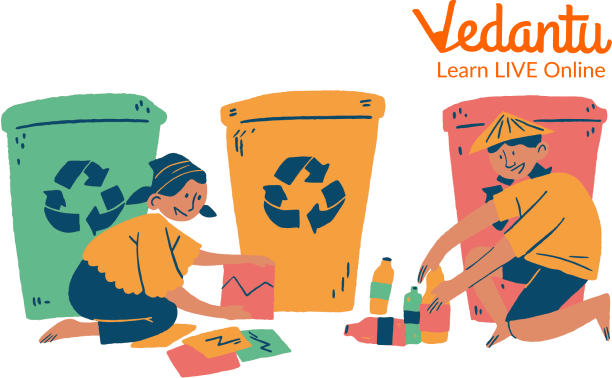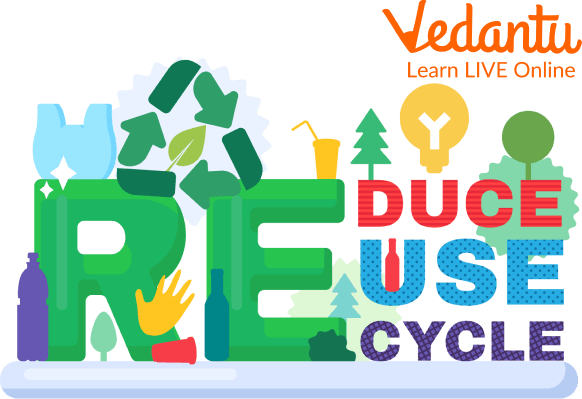




Introduction To Recycling For Kids
Kids, I am sure you all throw garbage in the dustbin. We learn this manner at our home and in school too. But what if we do not throw useful garbage? Do not get shocked. Yes, we can do so. This process is known as recycling. So, let us learn about recycling in detail. Recycling is a method for taking garbage and transforming it into new items. The absolute most normal cycles being used today include reusing plastic, glass, metals, paper, electronics, and materials. These all are the recycling of waste materials for kids. Regularly utilised things made of these materials incorporate soft drink jars, plastic milk containers, papers, old PCs, and cardboard boxes. Here we will learn how recycling is helpful in our everyday life.

Recycling
How Does Recycling Work?
Make sure to reuse all that you can in your home and school. There is quite often a "recycle" garbage bin around. Also, you can drop your pre-used aluminium jars and plastic containers there. At home, make sure to put paper-based things like used papers, cereal boxes, and schoolwork pages into the recycle bin. This will be a recycling activity for kids. This will be a recycling activity for kids and also waste management for kids.
Aluminium Jars - Aluminium jars were possibly the earliest to be intensely reused. The cycle isn't exactly as convoluted as it seems to be for a few different materials. The jars are first destroyed and afterwards softened. From that point, the aluminium can be used to make new jars and other things.
Plastic Jugs - There are a ton of kinds of plastics and each type is produced using an alternate mix of synthetic compounds.
Accordingly, plastic containers are first arranged into different substance types. Then, at that point, they are cleaned to dispose of any extra food or other waste. Then, the containers are squashed or destroyed into fine plastic chips.
Then the chips can be broken down to make new plastic or transformed into a fibre utilised for making floor coverings or dresses.
Paper - Paper begins its recycling by being blended in with water and different synthetic compounds to separate it. It then, at that point, gets destroyed and warmed up.
This process finally transforms the paper into a mash or slurry. The mash sets are stressed up to eliminate any pastes or plastics. From that point onward, it gets cleaned and faded to eliminate any leftover inks or colours. Presently the mash is fit to be made into new paper.
PCs and Batteries - Computers and batteries are typically reused to eliminate unsafe synthetic compounds and recuperate or recover a few significant materials, for example, gold from hardware sheets. This is a recycling of waste materials for kids and waste management for kids.
The Recycling Loop
The recycling loop has three bolts. Every arrow addresses an alternate move toward the recycling system. This means Gathering recyclable materials, similar to aluminium jars and plastic jugs. Handling the old materials and making new things. Purchasing things produced using recycled materials.

Recycling Loop
Summary
Plastics are normally set apart with an ID code that shows a recycling image and a number from 1 to 7. This shows the chemicals, or polymer used to make the plastic. Utilised paper can be recycled multiple times. After this, the fibres get excessively short and are sifted through by the reusing system. Some waste material is transformed into power energy by consuming it in current incinerators. Glass is one of the most incredible recycling materials. Clear glass can be reused again and again. In 2009, the United States reused around 1/3 of its waste. Around 7 million tons of metals were reused.
FAQs on Recycling For Kids
1. How can we increase recycling?
Recycling can be increased by taking a few steps such as we can buy recycled products, we can avoid using garbage bags, reusing water, we can spread awareness among people and making them understand the benefits of recycling.
2. How does recycling help our speech?
There are various advantages to recycling. These include:
Landfills - Recycling materials implies less junk and saves space in dumps and landfills.
Assets - When we use materials once more, this implies we can take fewer assets from the Earth.
Contamination - by and large, reusing materials can deliver less contamination assisting with keeping our current circumstances clean.
Decreases how much waste is shipped off landfills and incinerators. Preserves normal assets like wood, water, and minerals. Increments financial security by drawing from a homegrown wellspring of materials. Forestall contamination by decreasing the need to gather new natural substances. Saves energy.
3. What happens if everyone recycled?
The world would look a lot different if everyone recycled. Most likely, it would be cleaner and use available resources more. Landfills would shrink tremendously. Recycling plants would be an epicentre of activity.









